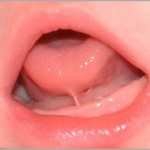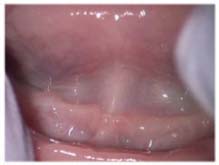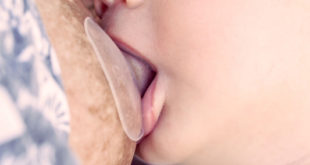When we hear the term “tongue-tie”, most of us have a mental image of someone who is struggling to speak in public, but who is stammering nervously and is at a loss for words. In reality, tongue-tie is a medical condition that affects many people, and has special implications for the breastfed baby.
Tongue-tie is congenital (present at birth) and may be hereditary (often more that one family member has the condition). Studies estimate that tongue- tie is present in between 4-22 babies per 1,000 births, and for some reason it occurs more often in boys than in girls.
Because it’s a relatively common condition, every newborn examination should include checking for the presence of tongue or lip tie.
The medical term for the condition known as tongue-tie is “ankyloglossia”. It results when the frenulum (the band of tissue that connects the bottom of the tongue to the floor of the mouth) is too short and tight, causing the movement of the tongue to be restricted.
Babies can also have tight frenulums on their upper lips. “Lip tie” refers to a condition where the upper lip is attached to the jaw tissue, which may prevent it from flaring out far enough to move normally and create the seal needed for effective breastfeeding.
There are several types of tongue and lip tie.
ATT Anterior tongue tie: Most obvious: Toward the front

PTT: Posterior Tongue Tie: tongue tie is hidden UNDER the mucus lining of the tongue/mouth.

ULT: Upper Lip Tie – almost everyone has an upper lip frenulum, but only those with restriction of function of the upper lip are defined as having a lip tie (photo)

In most cases, babies who have an anterior tie will also have a posterior tie. Clipping the more obvious anterior tie may not be enough to correct the feeding issues. The lip tie should also be assessed and addressed if necessary.
One informal way to tell if your baby is tongue-tied is to look at him and stick out your tongue. Even tiny babies will imitate you. If he is unable to extend his tongue fully, or if it has a heart shaped appearance on the tip, then you should have him examined by his health care provider. You can also try putting your finger in his mouth (pad side up) until he starts sucking. See if his tongue extends over his gum line to cup the bottom of your finger. If not, you may want to have him evaluated.
Posterior ties can be tricky to diagnose. They aren’t as obvious as anterior ties, and are often missed during a visual exam. You can’t see a posterior tie, but if your run your finger from side to side underneath the tongue, you can feel a bumpy band of tissue where the tongue tie would be.
Not every tongue or tie needs to be corrected. In most cases, the frenulum recedes on its own during the first year, and causes no problems with feeding or speech development. A lot depends on the degree of the tongue-tie: if the points of attachment are on the very tip of the tongue and the top ridge of the bottom gum, feeding and speech are more likely to be affected than if the frenulum is attached further back.
Severe ties can cause problems with speech. Certain sounds are difficult to make if the tongue can’t move freely (especially ‘th’, ‘s’, ‘d’, ‘l’, and ‘t’). In addition to forming specific sounds, tongue-tie may also make it hard for a child to lick an ice cream cone, stick out his tongue, play a wind instrument, or French kiss. While these may not seem like important skills to you as a new mother, someday they may be very important to your child! Dental development may also be affected, with severe tongue or lip tie sometimes causing a gap between the upper or lower front teeth.
Of more immediate importance is the negative impact that a tight frenulum can have on a baby’s ability to breastfeed effectively. In order to effectively extract milk from the breast, the baby needs to move his tongue forward to cup the nipple and areola, drawing it back in his mouth and pressing the tissue against the roof of his mouth. This compresses the lactiferous sinuses (the pockets behind the areola where the milk is stored) and allows the milk to move into the baby’s mouth. The tongue plays an important role in breastfeeding, and if the baby’s frenulum is so short that his tongue can’t extend over the lower gum, he may end up compressing the breast tissue between his gums while he nurses, which can cause nipple soreness or damage. The baby with a tight upper lip tie may not be able to curl his lip out enough to form a tight seal on the breast. He may not be able to remove an adequate amount of milk, and may swallow air during feeding, causing gassiness or reflux.
Tongue-tie can cause feeding difficulties such as low weight gain and constant fussiness in the baby. Nursing mothers may experience nipple trauma (the pain doesn’t go away no matter what position is used), plugged ducts, and mastitis.
In addition to problems with nipple soreness and low weight gain, some other signs that the baby may be having problems breastfeedinng effectively include breaking suction often during feedings, milk dribbling out, and making a clicking sound while nursing.
Some tongue-tied babies are able to nurse effectively, depending on the way the frenulum is attached, as well as the individual variations in the mother’s breast. If the mother has small or medium nipples, the baby may manage to extract the milk quite well in spite of being tongue-tied. On the other hand, if the nipples are large and/or flat/inverted , then even a slight degree of tongue or lip tie may cause problems for a breastfeeding baby.
Since these symptoms can also be caused by other problems, it’s a good idea to be evaluated by a knowledgeable health care provider (an IBCLC, if possible) to rule out causes other than tongue-tie. Tongue-tie should definitely be considered a possibility if breastfeeding doesn’t improve even after other measures such as adjustments in positioning have been tried.
If it is determined that tongue or lip tie is causing breastfeeding difficulties, there are some relatively simple medical procedures that can correct the problem.
Tongue-tie revisions (frenotomy) can be done by clipping with scissors or by laser. Both methods have pros and cons ( see Laser vs Scissor Technique for Tongue/Lip Tie Release ) but have the same outcomes. Both are quick, relatively painless procedures that can be performed in the office without sedation, using topical or injected anesthetic (lidocaine). The scissor method is faster (certainly a consideration with a squirmy newborn). Both methods cause minimal bleeding, but in cases where bleeding might be a concern (thick frenulum or deep posterior tie), the laser method may be preferred.
The baby is put on the breast immediately following the procedure, and the bleeding stops almost instantly. Anesthesia and stitches are not necessary. The baby cries more because he is being restrained for a few seconds than he does because of pain. In most cases, the mother notices an immediate improvement in both her comfort level and the baby’s ability to nurse more efficiently.
The earlier the problem is identified, and the frenotomy is done, the less time it will take him to nurse effectively and comfortably after the procedure. If the tongue-tie isn’t identified and the frenulum isn’t clipped until the baby is several weeks or months old, then it may take longer for him to learn to suck normally. Sometimes suck training is necessary in order for him to adapt to the new range of motion of his tongue. If tongue-tie is causing severe breastfeeding difficulties, then the sooner the frenulum is clipped, the better. Sometimes children end up having the procedure done when they are much older, because the problem isn’t identified until after they begin developing significant speech problems.
Even though clipping the frenulum is a simple, safe, and uncomplicated procedure, it may be difficult to find a doctor who is willing to perform it. The history of treating tongue-tie is somewhat controversial. Up until the nineteenth century, baby’s frenulums were clipped almost routinely. Because of the potential for feeding and speech problems, midwives were reported to keep one fingernail sharpened so that they could sweep under the tongue and snip the frenulum of just about all newborn babies. Any procedure that involves cutting tissue in the mouth can potentially involve infection or damage to the tongue, especially back in the days before sterile conditions and antibiotics. Because the procedure was done so often, even though in most cases it wasn’t really necessary, doctors became very reluctant to clip frenulums at all and the procedure was rarely performed.
Part of the reason frenotomies fell out of favor for many years was the fact that doctors discovered that in all but the most severe cases, speech was not affected by tongue-tie. They preferred to take a “wait and see” approach and let nature take it’s course. Most of the time, the frenulum would stretch out on its own with no intervention.
During the same time period that frenotomies were becoming less common, the rate of breastfeeding also declined dramatically. Bottle-feeding doesn’t present the same feeding difficulties for tongue-tied babies that breastfeeding does, because the mechanics are very different and extension of the tongue doesn’t play as big a role in feeding from the bottle. Since the majority of babies were bottle fed, it was easy for doctors to say that they weren’t going to perform an “unnecessary procedure” that didn’t interfere with feeding, and rarely caused speech problems.
Even today, with nearly 80% of the infants in this country starting out breastfeeding, it may be difficult to find a doctor who recognizes the problem that tongue or lip tie can cause for a nursing baby and is willing to perform a frenotomy. The procedure is seldom mentioned in the pediatric literature, and is no longer routinely taught in medical school. As the number of mothers initiating breastfeeding increases, so will the number of health care providers who are aware of the impact tongue-tie has on nursing infants, and know how to diagnose and correct it.
If you feel that your baby’s breastfeeding difficulties may be due to tongue-tie, you may need to work at finding a health care provider who can diagnose the problem and clip the frenulum. Many medical professionals have never heard of an upper lip tie, or a posterior tongue tie. Even those who have may not have a clue about how they affect breastfeeding moms and babies. Although any pediatrician or general family practitioner can theoretically perform a frenotomy, many prefer to make a referral to an oral surgeon, dentist, or an ENT specialist.
If possible, consult an IBCLC (International Board Certified Lactation Consultant). She can make a referral based on her assessment and direct you toward a knowledgeable and experienced specialist who can evaluate, diagnose, and effectively treat your baby’s tongue or lip tie.
Here’s how to locate an IBCLC in your area: https://uslca.org/resources/find-an-ibclc
Additional resources: International Affiliation
of Tongue Tie Professionals
Tongue Tie: Information for parents and practitioners http://tonguetie.net/
References
- Ghaheri BA, et al. Breastfeeding Improvement Following Tongue-Tie and Lip-Tie Release: A Prospective Cohort Study. Laryngoscope. 2016 Sep 19. doi: 10.1002/lary.26306
- Meg Nagle, IBCLC: When unexplained breastfeeding pain is an indicator of tongue and lip ties
- Dr. B. Ghaheri How Does an Upper Lip Tie Affect Breastfeeding?, March, 2014
- Surgical techniques for the treatment of ankyloglossia in children: a case series: Journal of Applied Oral Science: 2014 May-Jun; 22(3): 241–248.
- Kumar, M. and |Kalke E.: Tongue-tie, breastfeeding difficulties and the role of Frenotomy, Acta Paediatrica, 2012
- Edmunds, Miles, and Fulbrook: Tongue-tie and Breastfeeding: a Review of the Literature, Breastfeeding Review, 2011 Mar;19(1):19-26
- Cho A, Kelsberg G, Safranek S. When should you treat tongue-tie in a newborn? Journal of Family Practice, 59(12) 2010: 712a-712b.
- Hogan M, Westcott C, Griffiths M. Randomized, controlled trial of division of tongue-tie in infants with feeding problems. J Paediatr Child Health. 2005 May-Jun;41(5-6):246-50.
- Kotlow, Lawrence A: D.D.S. P.C. The significance of tongue and lip ties and why you should consider correcting them
Please ‘Pay it Forward’!*
If you found any of the information in this article, helpful, please consider making a small donation to my favorite cause – Project Pets: Spay, Neuter, Love – all volunteer, non-profit organization that provides free spay and neuter services for homeless rescue dogs and cats…because every baby deserves a home, whether they have two legs or four! To find out how you can help, visit Project Pets on Facebook.
The tongue plays an important role in breastfeeding, and if the baby’s frenulum is so short that his tongue can’t extend over the lower gum, he may end up compressing the breast tissue between his gums while he nurses, which can cause nipple soreness or damage. The baby with a tight upper lip tie may not be able to curl his lip out enough to form a tight seal on the breast.
 Breastfeeding Basics
Breastfeeding Basics





